Interaction and Innovation, c. 200 BCE–300 CE - 1 | History for UPSC CSE PDF Download
Copper Coins of the Yaudheyas, Ayodhya, and the Kunindas
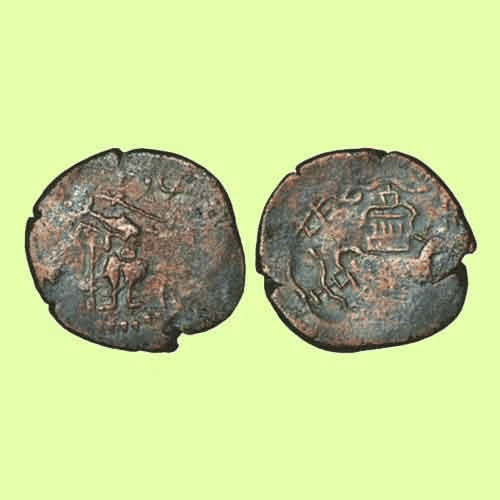
The growth of state polities and the expansion of urban centers and trade led to significant advancements in coinage. The Indo-Greeks were the first to introduce bilingual and bi-script legends on their die-struck coins, and much of what we know about these kings comes from their coinage.
- The Kushanas minted large quantities of gold coins, as well as copper coins of low denominational value. In the Deccan, the Satavahanas issued coins made of silver, copper, lead, and potin. Roman gold coins flowed into peninsular India in large quantities due to flourishing Indo-Roman trade interactions.
- Locally made imitations of Roman gold coins were also produced and used. Some of the punch-marked coins found in the far south can be tentatively identified as dynastic issues based on their motifs. There are also definite dynastic issues with legends, some featuring portraits, of the Chola, Chera, and Pandya kings.
- Several intriguing coins, mostly made of copper or bronze, provide insights into the political and economic institutions of the time. These include coins issued by non-monarchical states such as the Arjunayanas, Uddehikas, Malavas, and Yaudheyas.
- A number of 'city coins' were presumably issued by the urban administration of cities such as Tripuri, Ujjayini, Kaushambi, Vidisha, Airikina, Mahishmati, Madhyamika, Varanasi, and Taxila. A handful of negama (nigama) coins reflect the power and authority of merchant guilds.
The Shungas
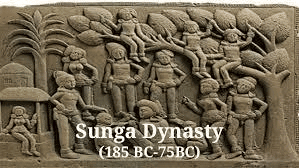
- According to the Harshacharita , Pushyamitra, the commander-in-chief of the Maurya army, assassinated King Brihadratha of the Maurya dynasty in 187 BCE. This act marked the end of Maurya rule.
- The Puranas describe Pushyamitra as belonging to the Shunga family. Various sources suggest that the Shungas were Brahmanas, with connections to the Bharadvaja gotra.
- Pushyamitra’s empire covered only a portion of the Maurya empire, including Pataliputra, Ayodhya, and Vidisha. He appointed viceroys in parts of his empire, as seen in the Malavikagnimitra , where Agnimitra, Pushyamitra’s son, is the viceroy at Vidisha. The drama also depicts Pushyamitra’s victory over Yajnasena, the king of Vidarbha.
Coins of the Indo-Greeks
- Graeco-Bactrian Coins: These coins, circulating to the north of the Hindu Kush, were made of gold, silver, copper, and nickel. They followed the Attic weight standard and featured Greek legends. The coins typically displayed royal portraits on the obverse (front) and Greek deities like Zeus, Apollo, and Athena on the reverse (back), along with the king's name and title.
- Indo-Greek Coins: These coins, used to the south of the Hindu Kush, were made of silver and copper, often in a square shape. They had bilingual inscriptions in Greek and Kharoshthi (and occasionally Brahmi) and adhered to an Indian weight standard. While royal portraits appeared on the obverse, the reverse motifs were inspired by Indian religious symbols rather than Greek ones. Notable coins from this series include those of King Agathocles, which depicted Samkarshana Balarama on one side and Vasudeva Krishna on the other.
- Coin Finds in Afghanistan: Several significant finds of Graeco-Bactrian and Indo-Greek coins have been made in Afghanistan:
- Mir Zakah Hoard: Found near Gardez, this hoard included 13,083 coins, with 2,757 identified as Graeco-Bactrian and Indo-Greek. The rest comprised Indian bent-bar and punch-marked coins, as well as Indo-Scythian, Indo-Parthian, and Kushana coins.
- Qunduz Hoard: This hoard contained 627 silver coins, primarily Graeco-Bactrian, with a few Seleucid coins. Various coins from different periods were discovered during excavations at this site.
- Aï-Khanoum: A smaller hoard at this site included six coins of Indo-Greek king Agathocles and 677 Indian punch-marked coins, suggesting the palace area was buried when the city was abandoned. Other hoards found at Aï-Khanoum contained Greek and Graeco-Bactrian coins, with some unique coin types and evidence of a local mint.
- Understanding the Indo-Greek coins is challenging due to the monograms and additional letters and numbers found on some coins. Monograms are usually seen as marks of a mint or moneyer. However, when different monograms appear on coins made with the same obverse die, they do not seem to indicate the mint. As for the numbers, it is unlikely that they represent dates or ordinal numbers for different issues. There is a slight possibility that the additional letters signify the engraver's signature.
- Out of the 42 Graeco-Bactrian and Indo-Greek kings, 34 are known only through their coins. The coins of the Shakas, Parthians, and Kshatrapas followed the basic features of Indo-Greek coinage, including bilingual and bi-script legends.
- The names of many Indo-Greek rulers are known from their coins. However, the details of their reigns, their sequence and chronology, and the extent of their political control remain rather unclear. The large number of kings within a relatively short period suggests that some of them ruled at the same time. Over-struck coins indicate either hostile relations between the two rulers in question or the fact that one of them succeeded the other.
- Demetrius I, Demetrius II, Appollodotus, Pantaleon, and Agathocles were responsible for extending Bactrian rule to the south of the Hindu Kush into north-western India. A protracted feud between the ruling houses of Euthydemus and Eukratides began after the reign of Demetrius I. Kings Amyntas, Antialkidas, Archebius, and Hermaeus belonged to the house of Eukratides. The Besnagar pillar inscription suggests that the rule of Antialkidas extended up to Taxila, as his ambassador Heliodorus is described as a native of that city.
Silver Coin of Apollodotus I
- Menander, also known as king Milinda, was a significant Indo-Greek ruler whose reign extended over parts of Bactria and northwestern India. He is famously depicted in the Buddhist text Milindapanha, where he poses questions to the monk Nagasena.
- A fragmentary Kharoshthi inscription found on a casket at Bajaur, in the North-West Frontier Province of Pakistan, refers to relics of the Buddha being enshrined during the reign of a king named Minedra, identified with Menander. Plutarch records a conflict over Menander’s ashes after his death.
- The Parthian defeat of Hermaius in the late 2nd century BCE marked the end of Greek rule in Bactria and the area south of the Hindu Kush. However, Indo-Greek rule continued in northwestern India, with rulers like Queen Agathokleia and her son Strato. Agathokleia, possibly one of Menander I’s queens, may have ruled jointly with Strato until he came of age.
- Indo-Greek control over the Gandhara region ended due to conflicts with the Parthians and Shakas. Their control east of the Jhelum River concluded in the late 1st century BCE or early 1st century CE with the defeat by the Kshatrapa ruler Rajuvula.
- A significant cultural impact of Indo-Greek rule was the emergence of the Gandhara school of art, which will be discussed later.
The Shaka-Pahlavas or Scytho-Parthians
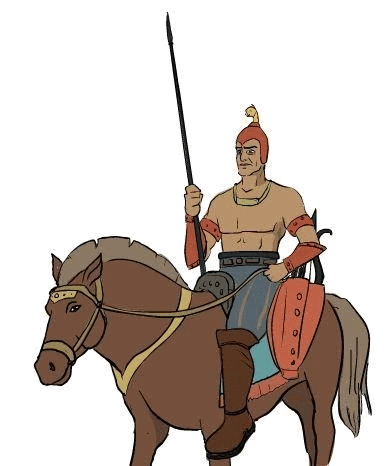
In the 6th century BCE, the Shakas, a group of Scythian ethnic origin, resided in the plains of the Syr Darya (Jaxartes). However, during the 3rd century BCE, the unification of the Chinese empire under Emperor Qin Shi Huang triggered a wave of tribal migrations in Central Asia. By the 2nd century BCE, the Great Yueh Chi tribe had displaced the Shakas, forcing them to move southward into Afghanistan and subsequently into northwestern India.
Ancient Parthia and the Pahlavas
- Ancient Parthia, corresponding to present-day Khurasan and the area southeast of the Caspian Sea, was inhabited by people known as Parthians or Pahlavas.
- In the 1st century BCE, various groups of invaders, referred to as Shaka-Pahlava or Scytho-Parthian, migrated from Parthia into northwestern India.
Evidence of Scytho-Parthian Rule
- The history of Scytho-Parthian rule in India is primarily known through inscriptions and coins.
- An inscription found at Taxila mentions a Shaka king named Moga and his governor Patika. Moga is believed to be the same as Maues or Moa, whose name appears on various coins similar to those issued by the Indo-Greeks.
Coins and Rulers
- Coins from this period feature various Scytho-Parthian kings, including Vonones, Spalirises, Azes I, Azilises, and Azes II.
- Some coins indicate the practice of joint rule among these kings. For example, Spalirises may have initially been a subordinate of Vonones before becoming an independent king.
- The Vikrama era of 58/57 BCE, once thought to mark the accession of Vonones, is now believed to mark the accession of Azes I.
Expansion of Rule
- Vonones and Spalirises ruled parts of Afghanistan, while Azes I extended his control into northwestern India.
- Azilises expanded further east into the Mathura region.
Gondophernes and His Successors
- Another significant Scytho-Parthian ruler was Gondophernes, identified with king Guduvhara from an inscription at Takht-i-Bahi, dating his rule to the mid-1st century CE.
- Gondophernes is associated on his coins with various officials and family members, including his nephew Abdagases and military governors like Aspavarman and Sasa.
- His successors were eventually displaced from northwestern India by the Kushanas.
The Kushanas
The Ch’ien Han-shu and Hou Han-shu recount the chain reactions of tribal movements in Central Asia. The Hiung-nu defeated the Yueh-chi, who then moved westwards, displacing the Wu-sun of the Ili basin.
- This led to the division of the Yueh-chi into two groups:
- The Little Yueh-chi, which moved south and settled in north Tibet.
- The Ta-Yueh-chi or Great Yueh-chi, who moved west, displacing the Shakas from the Jaxartes area.
- The Great Yueh-chi were eventually driven out by the Wu-sun, aided by the Hiung-nu, and they migrated into the Oxus valley, settling in Afghanistan.
- In Afghanistan, there were five Great Yueh-chi principalities, one of which was the Kuei-shang (Kushanas). These principalities were under a central Great Yueh-chi authority. Recent evidence indicates that a Kuei-shang ruler named Miaos (or Eraos) established an independent Kuei-shang principality north of the Oxus in the late 1st century BCE.
- In the early 1st century CE, Kujula Kadphises (Kadphises I) unified the five principalities, laying the groundwork for the Kushana empire. His coins found south of the Hindu Kush suggest the Kushana movement into the Indian subcontinent began during his reign.
- Kujula Kadphises’ son, Vima Kadphises, initially co-ruled with his father and later independently ruled. He conquered Kandahar from the Parthians, and during his reign, the Kushanas expanded eastward, establishing control over the Indus valley and the Mathura region. While Kadphises I’s coins indicate a connection to Buddhism, Vima Kadphises’ coins depict him as a devotee of Shiva.
Gold Coin of Huvishka
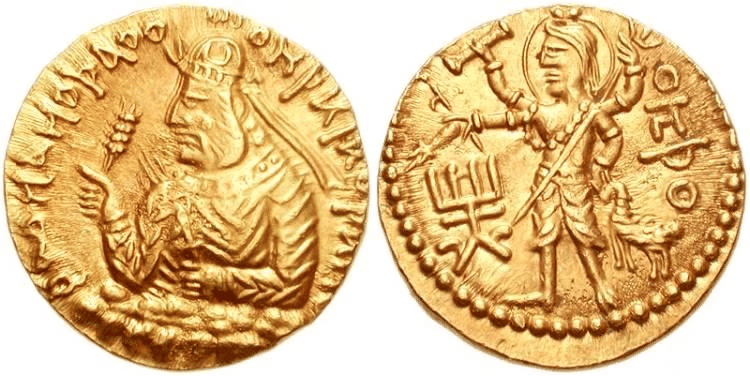
Expansion of the Kushana Empire Under Kanishka's Reign (78 CE onwards)
- The Kushana Empire reached its peak under Kanishka, who is widely believed to have started his reign in 78 CE.
- During his rule, the empire expanded further into the Ganga Valley and southward into the Malwa region.
- Kushana influence extended into western and central India, where local rulers acknowledged Kushana overlordship.
Trade and Economic Factors
- The presence of diamond mines in Akara (eastern Malwa) and the trade potential of the lower Indus region likely motivated Kushana expansion into these areas.
- The Kushanas grew wealthy and powerful through their control of the lower Indus region, which became crucial for Indian Ocean trade, particularly with ports on the Makran coast.
- The decline of this trade network was linked to the decline of the Kushana Empire.
Geographic Extent
- Kanishka's empire likely included most of Afghanistan (excluding Seistan), the easternmost part of Xinjiang in China, and parts of central Asia north of the Oxus River.
- The incorporation of these regions significantly boosted trade.
Military Campaigns
- Towards the end of his reign, Kanishka attempted a military expedition into central Asia against the Chinese but was defeated by General Pan-chao and forced to pay tribute to Emperor Ho-ti.
Gold Coin of Kanishka III
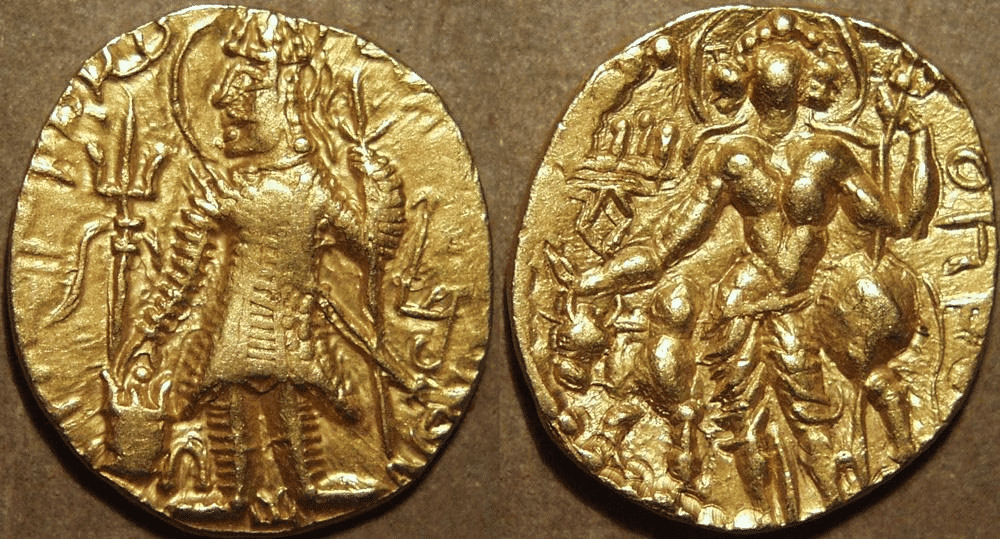
- Kanishka III was a Kushan king known for his support of Buddhism and religious tolerance. He is believed to have enshrined Buddha's relics in a stupa at Purushapura (modern-day Peshawar), which became a major center for Buddhism.
- During his reign, an important Buddhist council took place, possibly in Kashmir, Gandhara, or Jalandhara. Kanishka III is said to have supported Buddhist scholars like Ashvaghosha and Vasumitra and sent missionaries to regions like Kashgar, Yunan, and China.
Coinage and Religious Motifs
- Kanishka's coins, similar to those of Huvishka, featured a wide range of religious motifs from Indian, Greek, and West Asian traditions. These included images of the Buddha, Shiva, and Persian gods like Atash (fire god) and Mithra (sun god), as well as Greek deities such as Helios (sun god) and Selene (moon goddess).
- This variety reflects Kanishka's personal religious eclecticism and the empire's religious diversity. It also shows the kings' efforts to connect with the deities worshipped in their realm.
Expansion and Centers of Power
- The Kushan Empire, originally a Central Asian kingdom, expanded into Afghanistan and northwestern India, with Bactria as its center. The use of the Bactrian language in Kanishka's coins and inscriptions and historical records like the Hou Han-shu indicate Bactria as the Kushan capital.
- In India, important centers of Kushan power included Purushapura (Peshawar) and Mathura. Excavations in north India, Central Asia, and Afghanistan have provided more information about this period.
Successors and Decline
- Kanishka was succeeded by kings like Vasishka, Huvishka, Kanishka II, and Vasudeva I. Inscriptions in Kharoshthi on a rock in Hunza mention these kings and various kshatrapas and mahakshatrapas.
- The empire began to decline during Vasudeva I's reign in the mid-2nd century CE, with Vasudeva II being the last Kushan emperor. Kushan rule in northwestern India ended in the 3rd century CE, but remnants of their rule persisted until the 4th century.
Titles and Control
- The Kushan kings used the title devaputra, which historians believe elevated the king's status to a divine level, similar to practices in other ancient empires. It is suggested that a shrine at Mat near Mathura may have been a place where images of these kings were worshipped, although this is not definitively proven.
- The Kushan empire had various tiers of control, with some areas under direct royal control and others governed by subordinate rulers known as kshatrapa or mahakshatrapa. Some subordinate rulers acknowledged Kushan supremacy and paid tribute, while others, like Kshatrapa Chashtana, recognized Kushan suzerainty but maintained a degree of autonomy.
Recent Archaeological Findings: The Rabatak Inscription
- In 1993, an inscribed stone slab was found in Rabatak, Baghlan province, Afghanistan, along with fragments of a lion sculpture and temple ruins on a hill known as Kafir's Castle. Sayyid Jafar, the provincial governor, encouraged Tim Porter, a British charity worker, to photograph the remains and share them with the British Museum. One significant photograph showed a rectangular piece of stone with an inscription.
- The inscription, consisting of 23 lines written in the Bactrian language using Greek script, dated to the reign of Kanishka. It portrayed Kanishka as a great and righteous ruler, emphasizing his divine status and kingship granted by the goddess Nana and other deities. The text noted Kanishka's decision to replace the Greek language with noble Bactrian.
Contents of the Inscription
- Command to Build a Temple: Kanishka ordered an officer named Shaphara to construct a temple (bago-laggo) dedicated to the goddess Nana and other deities.
- Statues of Ancestors: The king instructed Shaphara to create images of his great-grandfather Kujula Kadphises, grandfather Saddashkana, father Vima Kadphises, and himself.
- Worship Leadership: A person named Nokonzoka was designated to lead worship in the newly built temple.
- Invocation of Deities: The inscription invoked various deities to ensure Kanishka's health and success, indicating the king's devotion to these gods.
- Beginning of a New Era: It suggested that Kanishka initiated a new era from the year he assumed power.
Significance for Kushana Genealogy
The Rabatak inscription provides crucial insights into Kushana genealogy. Scholars had differing interpretations of a specific line in the inscription:
- N. Sims-Williams and Joe Cribb believed it referred to a previously unknown Kushana king named Vima Takto, son of Kujula Kadphises.
- B. N. Mukherjee argued that the name referred to Saddaskana (Sadashkana), Kujula Kadphises's son.
The inscription clarified that Vima Kadphises and Kanishka were father and son.
Kanishka's Empire
- Territories Included: The inscription listed territories such as Kaundinya, Ujjayini, Saketa, Kaushambi, Pataliputra, and Champa as part of Kanishka's empire.
- Exaggerated Claim: It made an exaggerated claim of Kanishka ruling over all of India, suggesting his influence extended to Pataliputra and Champa in the east.
- Kaundinya Identification: Kaundinya or Kundina was identified with Kaundinyapura on the Wardha river in Maharashtra's Amaravati district, possibly marking the empire's southern border.
Kushana Concept of Kingship
- The Kushana inscription provides insight into their view of kingship. Kanishka, the king, claimed to have gained his kingship with the help of various deities, primarily Zoroastrian, led by the goddess Nana.
- The inscription also mentions the presence of images of the current king and his ancestors in relation to a temple that had been constructed.
- Stone statues of Kushana kings have been discovered in temples at Surkh Kotal in Afghanistan and Mat near Mathura. There is a possibility that similar statues may be found at Rabatak in the future.
- A key question arises regarding the nature of these statues: Were the kings’ images part of temples dedicated to different gods, or were they objects of worship themselves? Did the Kushana kings assert a close relationship with the gods, or did they claim to be gods?
Resurfacing of Polities after Kushana Decline
Shaka Kshatrapas:
- Emerged in western and central India following the decline of the Kushanas.
Arjunayanas:
- Located in the Bharatpur and Alwar areas of north India.
- Their coins, dating to the late 1st century BCE, bear the inscription "Arjunayananam jayah," meaning "victory to the Arjunayanas."
Malavas:
- Originally from the Punjab region, a large portion of the Malavas migrated to Rajasthan.
- Their capital, Malavanagara, is identified with modern-day Nagar in Rajasthan.
- Numerous coins referencing the Malava janapada have been discovered in and around Nagar, with inscriptions such as "jayo Malavanam" or "Malavanam jayah."
- A lead seal found at Rairh contains a legend referring to the Malava janapada in 2nd-century BCE Brahmi letters.
Yaudheya Gana:
- Inhabited eastern Punjab and adjacent areas of Uttar Pradesh and Rajasthan.
- Their coins have been found from Multan to Saharanpur.
- A clay sealing discovered at Sunet near Ludhiana features a bull motif and the inscription "Yaudheyanam jaya-mantradharanam," meaning "of the Yaudheyas, the possessors of the secret charm of winning victories."
- Coins and moulds bearing the Yaudheya name at this site suggest that Karttikeya was their tutelary deity.
Local Coin of Ujjain
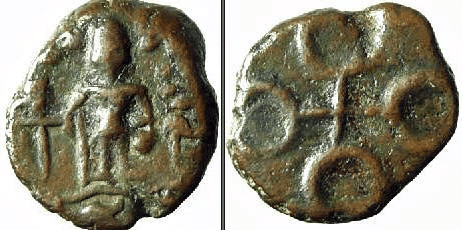
During this period, several kings in north and central India, known as Naga kings because of the ‘naga’ suffix in their names, ruled over different parts. The evidence from texts and sculptures suggests that the worship of nagas, or snake deities, was quite popular in these regions. Inscriptions, coins, seals, and sealings reveal the existence of several Naga kings.
- The Puranas mention a line of nine Naga kings ruling from Padmavati, which is identified with modern Pawaya in the Gwalior district of Madhya Pradesh. Coins bearing the name of a ruler called Ganendra or Ganapa have been discovered in Padmavati, Mathura, and Vidisha, along with other coins naming different Naga rulers from the same area.
- Additionally, the Puranas refer to seven Naga kings ruling from Mathura. Many coins from the Mathura region during this period feature rulers’ names ending in ‘mitra’ or ‘datta.’ Inscriptions and coins also mention various local dynasties ruling from places like Ahichchhatra, Ayodhya, and Kaushambi.
The Shaka Kshatrapas of Western India
The Kshatrapas
The Kshatrapas Dynasty
- In the early centuries CE, there were two prominent lines of Kshatrapa rulers in western India: the Kshaharatas and Kardamakas.
- The Kshaharata dynasty included notable rulers such as Bhumaka and Nahapana.
- Bhumaka :
- Initially, Bhumaka owed allegiance to Kanishka, a Kushana ruler.
- His coins, featuring legends in Brahmi and Kharoshthi scripts, have been discovered in coastal Gujarat, Malwa, and the Ajmer region.
- Nahapana (circa 119–25 CE):
- Nahapana is better known through his coins and inscriptions dated in an era, likely the Shaka era of 78 CE.
- His titles evolved from kshatrapa (subordinate ruler) to mahakshatrapa (great kshatrapa) and rajan (king) in his inscriptions.
- On his coins, he is simply referred to as rajan.
- Notably, his inscriptions do not mention any overlord, suggesting a degree of independence in his rule.
- Nahapana’s coins have been found in the Ajmer region of Rajasthan and the Nashik area in Maharashtra.
- Inscriptions of his amatyas (officials), such as Aryaman, have been discovered in places like Junnar in Pune district.
- At its peak, Nahapana’s kingdom likely encompassed Malwa, Gujarat, Saurashtra, northern Maharashtra, parts of Rajasthan, and the lower Indus valley.
- The capital, Minnagara, is possibly identified with Doha, situated between Ujjain and Broach.
- Nahapana’s son-in-law, Ushavadata, served as viceroy in the southern part of the kingdom, with several of his donative inscriptions found in the Nashik and Karle caves.
- The Shaka Kshatrapas were in a long struggle with the Satavahanas, a strong dynasty based in the Deccan region. Control over certain areas, particularly those providing access to the western coast, frequently changed between the two powers. For example, the Nashik and Pune regions were likely taken from the Satavahanas by Nahapana or one of his predecessors.
- However, around 124–25 CE, Nahapana was reportedly killed by Gautamiputra Satakarni, a ruler of the Satavahanas, who then seized the southern territories of the Kshaharata kingdom. Evidence of this includes the discovery of Gautamiputra’s inscriptions in the Nashik and Pune districts, his re-striking of Nahapana’s coins, and statements from an inscription by Gautamiputra’s mother, Gautami Balashri.
Coin of Nahapana
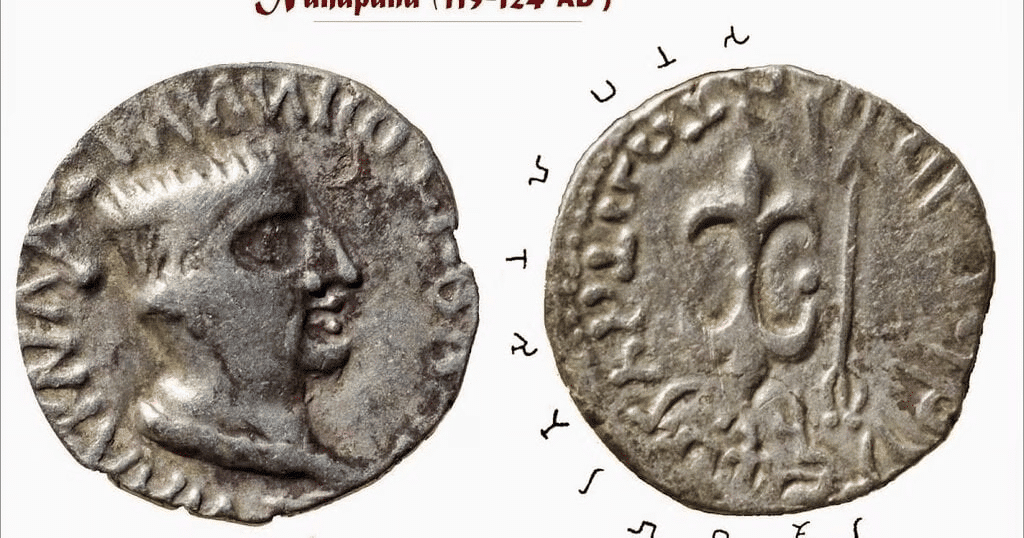
Introduction to the Kardamaka Dynasty
- Around the time the Kshaharata dynasty was ending, a new line of Shaka Kshatrapas called the Kardamakas emerged in western India.
- Chashtana, the founder of this dynasty, is seen on earlier coins as kshatrapa (a type of ruler) and later as mahakshatrapa (a higher rank), with the title rajan (king) appearing throughout.
- Chashtana may have initially ruled in the Sind area under the Kushanas but later became a viceroy of the southwestern provinces of the Kushana empire.
Rulers of the Kardamaka Dynasty
- The Kardamakas had a system of senior and junior rulers, with mahakshatrapa for senior and kshatrapa for junior.
- During Chashtana’s time, his son Jayadaman and grandson Rudradaman I held the title of kshatrapa.
- Rudradaman I succeeded Chashtana as mahakshatrapa and was successful in reclaiming territories lost to Gautamiputra Satakarni from Nahapana.
A Lake, a Storm, and a King
A rock in Junagadh, Gujarat, features Ashokan edicts, an inscription from Rudradaman, and one from Gupta king Skandagupta. Ashoka’s edicts discuss dhamma, while the latter two detail the history of a water reservoir over 1,000 years.
- Rudradaman’s Inscription
- Inscribed in Brahmi script and Sanskrit language, Rudradaman’s inscription is the first long Sanskrit inscription in the subcontinent.
- It records the restoration of Sudarshana lake by Rudradaman, originally started by Pushyagupta during Chandragupta Maurya’s reign and completed by Tushaspha during Ashoka’s rule.
- The Great Storm of 150 CE
- The inscription describes a severe storm in the winter of 72 (likely of the Shaka era, i.e., 150 CE).
- The storm caused massive flooding from the Suvarnasikata and Palashini streams, leading to widespread destruction.
- It breached the lake’s embankments, causing the lake to empty and transforming it from Sudarshana (beautiful) to durdarshana (ugly).
- People were very sad about the terrible event. The damage was so great that Rudradaman's advisors thought the lake was beyond repair. However, Rudradaman insisted on getting the work done. The project was overseen by the provincial governor of Anarta and Surashtra, amatya Suvishakha, who was praised as a capable and honest officer. The lake was strengthened and expanded significantly in a short time without imposing heavy taxes or forced labor on the people.
- Rudradaman ordered this work to benefit cows and Brahmanas for a thousand years, aiming for righteousness and lasting fame. The inscription also praises Rudradaman's lineage and his achievements, describing him as a strong and capable ruler who expanded his territory through valor.
- He is credited with defeating arrogant foes and ensuring peace and prosperity in his realms. The inscription portrays him as an ideal king with various commendable qualities, though it is uncertain how many of these traits he actually possessed.
Silver Coin of Rudrasimha I, Kardamaka Dynasty
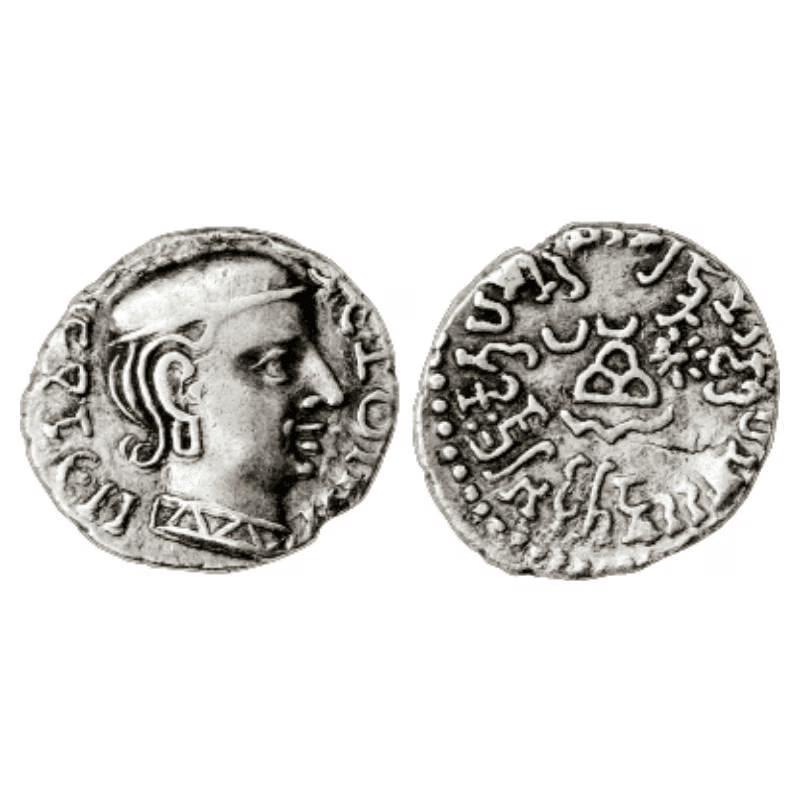
The Satavahana Empire in the Deccan
- Ashokan inscriptions indicate Maurya contact with the Deccan, particularly the southern region.
- B. D. Chattopadhyaya emphasizes numismatic evidence showing the rise of various small political principalities in the Deccan after the Maurya decline and before the Satavahanas.
- Coins of local rulers, often with the title maharathi, have been found in sites like Verrapuram and Brahmapuri, indicating increased power of local elites in the 2nd–1st centuries BCE.
- The Rathikas and Bhojas mentioned in Ashoka’s inscriptions evolved into the maharathis and mahabhojas of pre-Satavahana times.
- The Satavahanas are associated with the Andhras of the Puranas, with varying accounts of their rulers and duration.
- Historians disagree on the dynasty's chronology, with some suggesting a start in c. 271 BCE and others in c. 30 BCE.
- It is likely that the Satavahana rule began in the mid-1st century BCE and ended in the early 3rd century CE.
|
110 videos|653 docs|168 tests
|
FAQs on Interaction and Innovation, c. 200 BCE–300 CE - 1 - History for UPSC CSE
| 1. What were the main characteristics of the copper coins of the Yaudheyas, Ayodhya, and the Kunindas? |  |
| 2. How did the Shunga dynasty contribute to the development of coinage in ancient India? |  |
| 3. What is the significance of the gold coins of Huvishka and Kanishka III in the context of the Kushana Empire? |  |
| 4. What role did the local coin of Ujjain play in the economic landscape of ancient India? |  |
| 5. How did the silver coin of Rudrasimha I from the Kardamaka Dynasty reflect the political and cultural dynamics of its time? |  |
















